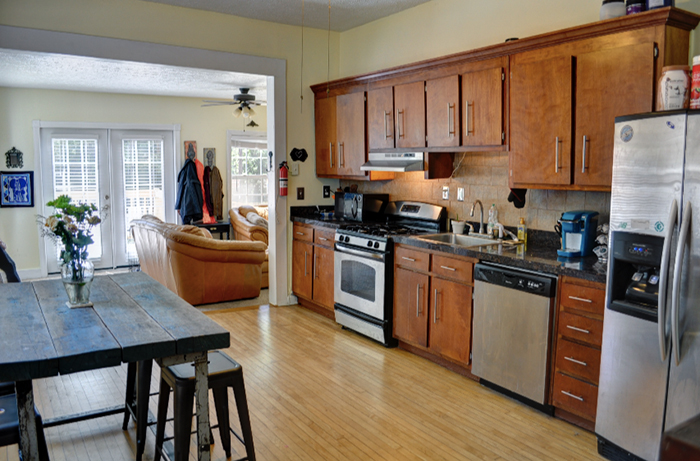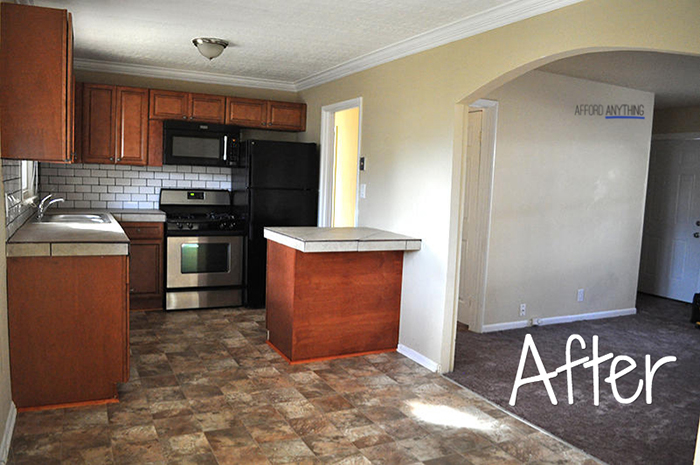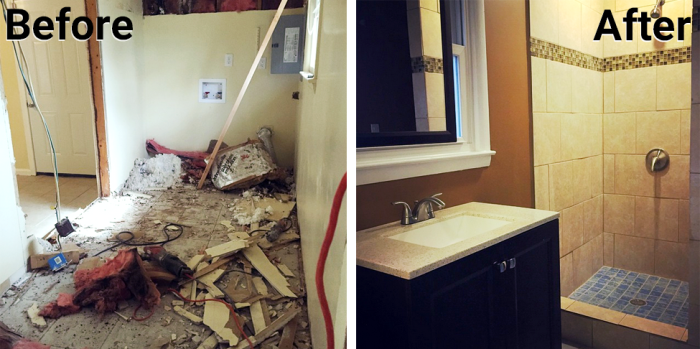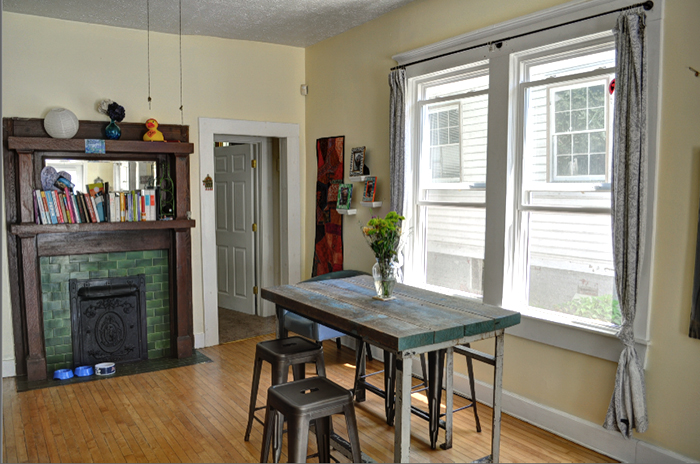
“Are you going to sell your properties?”
Now that I live in a different state than my rental investments, I hear this question a lot.
But people with the long-term Afford Anything mindset might phrase this differently. Instead of “will you sell?,” the better question might be, “how can you hold?”
How will I manage properties from waaayyyy across the country? More importantly, how can I help others do the same?
I’m not an expert or fancy-pants guru. I don’t have all the answers. I’m just someone who throws a ton of spaghetti at the wall and sees what sticks.
I experiment. I test. I try. I place “small bets,” see if they work, and scale from there.
And if you’ve been reading me for awhile, you know that I’ve been traveling a lot for the past couple of years.
I’ve had plenty of experience living far away from my properties; I’m good at disappearing for months at a stretch. While I realize this is different than planting roots elsewhere, I’m feeling pretty confident about this permanent move to the opposite coast.
I guess that still doesn’t answer the question “how.”
The short answer is that I’ve spent the past few years focused on creating systems, making improvements, and building an awesome team. This team can now run the business with minimal oversight from me.
To better answer this question, let me show you some examples.

Scene One
It’s June 2014. My flight lands in San Diego, and I notice the light beige tiles covering the airport walls. They’re inexpensive and beautiful.
I snap a photo and text it to my contractor. “Use this for the kitchen countertops. 16′ square ceramic. Dark grout. Diamond layout.”
He texts back: “I can see the diamonds.”
I respond: “Are you high?”
He retorts: “On life.”
We’re joking with each other. We’ve worked together on enough home remodels that we have that type of relationship. But in the midst of this humor, we’re also massively productive … remotely, by text message, while I stride across the airport terminal.
Over the next few weeks, I design and manage this kitchen remodel entirely by text message while traveling.
The white tile backsplash is inspired by New York’s subway system. The countertops are an ode to the San Diego airport. The cabinets are “the cheapest wood besides oak at the factory outlet store;” the carpet is “the cheapest 26 to 30 ounce variety in a dark neutral color at the wholesale supplier.”
Here’s the before and after:



In fairness, it wasn’t always this simple. I’ve managed 5 kitchen remodels in the past 5 years. The first one carried a massive learning curve. So did the second. But by the time I reached number 4 or 5, I’d become much more skilled at the process – and this allows me to streamline the work.
After I return home, I visit the property three or four times to inspect the contractors’ work.
On one of my last visits, I bring a mastermind group of other investors to the property. One guy notices that we can convert an unused space into a full bath, which will instantly boost the desirability. He’s right, I realize. I spend one afternoon taking measurements and sketching out plans.
Then I travel to New Orleans, followed immediately by Austin. Along the way, I send a few more text messages to my contractor.
The shower tile, I tell him, should be “same as the kitchen countertops, plus add neutral 4-6″ glass accent located 2/3rds of the way up.” The shower flooring is “surplus tile in our basement.” The vanity, sink and mirror are “cheapest dark-wood complete set at Home Depot.” Paint is the same hue we use on every property.
Here’s the final creation:

From Austin, I chat with a property manager by phone and e-sign a contract bringing him on board. Later, I receive an email: they’ve found a qualified tenant. They email me a copy of the lease.
That happened more than 6 months ago. I haven’t set foot in the property since.
But that doesn’t mean the property is neglected. My team goes there to clean gutters, change the HVAC filter, test the smoke alarm, handle pest control and respond to repair calls. I don’t bother showing up; they text me photos of the completed work.
Scene Two
It’s July 2015, and I’m in Colorado at a friend’s wedding. I grab my phone to snap some pictures, and happen to glance at my email.
I see a string of messages, telling me that a total of $8,308 in rental income is finding its way into my bank account. Not bad for a Thursday.

A few days later, I get pinged: Here’s another $805.50. And another $750.75. In total, $9,864.25 flows into my business bank account in the next few days, while I’m hanging out with friends in the mountains.
This is gross revenue, of course. There are contractors to pay; insurance premiums to cover; water, trash and tax bills to pay. The net varies wildly; I’m going to start posting monthly real estate income reports soon, so that you can see this firsthand.
It’s a good life, though … and it’s because we set up the income streams and business systems that made this possible.
Scene Three
It’s May 2015, and I’m in Brazil with a few friends. One of our tenants is moving out of one of our Atlanta properties, so I’m tasked with finding a replacement tenant … from 4,000 miles south.
On some properties, this wouldn’t be a blip on the radar. I hire property managers to handle the advertising, showings, screenings and lease signings; we barely notice a tenant turnover.
But this turnover is taking place in one of the properties I manage.
Did it ruin my trip to Brazil? Hardly. Here’s how much time it required:
Place Ad on Craigslist: 5 minutes. I re-use the same advertisement and photos from previous years.
Place Ad on Postlets: 5 minutes. Ditto. I just re-activate the old ad that’s saved in my account, changing the date and price.
Field Inquiries: 10 minutes. I have an email address specifically for rental inquiries. When a prospective tenant emails, they get an automated response that says: “Thanks for your interest. We are having an Open House on [Date], from [Start Time] to [End Time]. Please attend this Open House to tour the property and ask questions.” I also respond to one-off questions.
Open houses are a great way to show a property. It simplifies setting up showing times and creates natural competition among prospective tenants.
Conduct Open House: 10 minutes. I arrange for someone else in Atlanta to conduct the Open House. The answers to basic questions (like “how much are utilities?” and “what’s the pet policy?” and “tell me about the neighborhood?”) are pre-written into an FAQ template. (By the way, creating an FAQ sheet will put you ahead of 95% of other property managers.)
My 10-minute commitment consists of a quick phone check-in prior to, and after, the event.
Review Application: 10 minutes. The Open House generated an application! I process this application online through Cozy.co (affiliate link). After the potential tenant submits the application, Cozy notifies me by email. I review the applicant’s information. Once I’m satisfied, I click the “approve” button, which notifies her that her application is approved.

Set Up Online System: 10 minutes. I e-mail the new tenant a copy of the lease and electronically setup her rental payments through Cozy.
Field Emails: 15 minutes. The approved applicant emails me with a few questions that I haven’t pre-answered in the FAQs (like “is there cable TV hookup in the bedroom, or only in the living room?”).
I notice that a few of her questions should be included in the FAQ, and I make a note to incorporate these into our guide. This will prevent me from answering the same questions ad nauseum. Why un-automate the system?
And … I’m done! I’ve found a tenant, from Brazil, in less than one hour of total work. Schweet! ☺
I’m Calling a Time Out
Let’s pause for the halftime report.
First and foremost, I’m struggling to write this article in a way that balances two concerns.
On one hand, I don’t want to make this process seem too easy. Getting to this point in my life took a fair bit of work, and I don’t want to gloss over that fact.
On the other hand, so many readers have been asking me whether or not I’ll sell my properties (now that I live out-of-state) that I have to assume that many of you think this requires much more work than it actually does.
I’m not swingin’ hammers, yo.
I’m telling these stories with as much frankness and forthrightness as I can muster, and I hope (!!) that it leaves the right impression. Real estate is not easy money … but it’s also not a day-to-day job, once the right systems are in place.
Most people get paid once for the hours that they spend working. I collect ongoing payments, in perpetuity. Barring a major calamity, I expect to be earning this residual income for the rest of my life.
(By the way, we have a real estate course that includes step-by-step guides, checklists and templates covering this entire process. I’ve spent more than three years developing and refining the material. Sign up here if you’re interested in learning more).
Game On
Okay, back to the story, already in progress … At this point, we’ve confirmed our new tenant. We turn our attention to what truly matters: Hiking in Rio de Janiero, absorbing art and sculpture at Inhotim, visiting friends in Sao Paulo.
We drink too much wine. We embarrass ourselves bantering in bad Portuguese. We spend poolside afternoons with lifelong friends who traveled with us to Brazil.
This is the stuff of life. This is what it’s all for. Investing is the how. This is the why.

After we return to the U.S., we spend two hours facilitating the tenant turnover. Here’s what that looks like:
Pre-Inspection (20 minutes): The biggest source of landlord-tenant conflict is the security deposit. To avoid this conflict, we volunteer to make a “preliminary walk-through” (or “pre-inspection”) of the current tenant’s unit a few days prior to move-out. Afterwards, we tell her exactly what issues she’ll need to fix to receive her deposit back in full.
This creates a win-win: she gets her full deposit; we get an awesome-condition property. Both of us avoid conflict, ending the relationship on good terms. The preliminary walk-through is an optional step, but highly recommended.
Inspection (20 minutes): On move-out day, we conduct the “official” walk-through. She’d already corrected everything, so this is a mere formality.
Miscellaneous (20 minutes): Random email and texting; printing and filing.
Move-In Process (1 hour): We review the lease with the new tenant, page-by-page, to make sure she understands it thoroughly. We walk through the property together (move-in inspection), during which time the new tenant points out a few minor flaws she wants fixed. I snap photos, text them to my contractor, and he comes out the next day.
Total time: 3 hours Broken down into:
-
- 1 hour from Brazil – to find a new tenant
- 2 hours in Atlanta – to process move-in/move-out

There’s a trifecta of factors that allowed this to run smoothly: upfront work, building a team, and buying right.
Upfront work: Renovating the space, writing the Craigslist ad, snapping great photos, writing FAQ’s, creating a lease, setting up Cozy – these are examples of upfront work. Do it once, and you won’t need to think about it for the next decade.
Organization plays a huge role in this. If I needed to comb through my files to find a blank template for the move-out inspection checklist … well, that could take as much time as searching for your car keys. But if you spend the time upfront getting everything ready and organized, you’ll reap the benefits for years.
Building a team: This is crucial. Don’t hire the cheapest; hire the best. Surround yourself with talent; pay them well; get out of their way.
Thanks to amazing contractors, this narrative did not end with the phrase: … “and then I spent the afternoon shuttling back-and-forth to Home Depot.” That’s not how I want to spend my one short life.
Buying right: Holding a Class A property in a desirable location helps keep this passive. Otherwise, the space (1) may not have rented out so quickly, and (2) may have tenants that are harder to work with. Not every tenant will fix issues, even after you ask them to do so.
Your likelihood of getting an All Star Tenant depends on (1) location, location, location, and (2) the quality of the property, which is why I’m more than happy to splurge on stainless steel and fancy fixtures. Better property = better tenants. The only thing worse than an empty rental is a bad tenant.
I believe in diversification, though, which I why I own real estate across the risk spectrum (as I describe in detail here). I let the professionals manage these. If you have any Class B or Class C properties, hire a property manager, pronto.
Epilogue
“Wait – you’re into real estate and travel? How are those compatible?”
I hear that question often, presumably from people who assume I’m swinging the hammer myself.
But I operate my life by one simple philosophy: Don’t ask, “Can I do that?” Ask, “How can I do that?”
A few years ago, I set the goal of preparing my real estate business to run without me. A flurry of hard work consumed my last few years in general, and my last few months in Atlanta in particular.
If you’ve been reading me for a while, you’ve witnessed my transformation from the person I was four years ago — a micromanaging do-it-yourselfer — to a person who is now laser-focused on making this business as passive as possible.
As you’ve seen from the chart, passive is not free money. It’s characterized by working hard today so that you can enjoy the rewards in the future.
That focus allowed me to move across the country. It’s the reason I’m writing this article from Costa Rica today. And it’s something that I believe that anyone can accomplish, with a little hustle and a lot of heart.
P.S. Don’t forget to sign up to learn more about the real estate course. We have 1,000+ students and alumni inside.
P.P.S. Here’s my familiar plug for Instagram. Because, ya know, I’m addicted.
